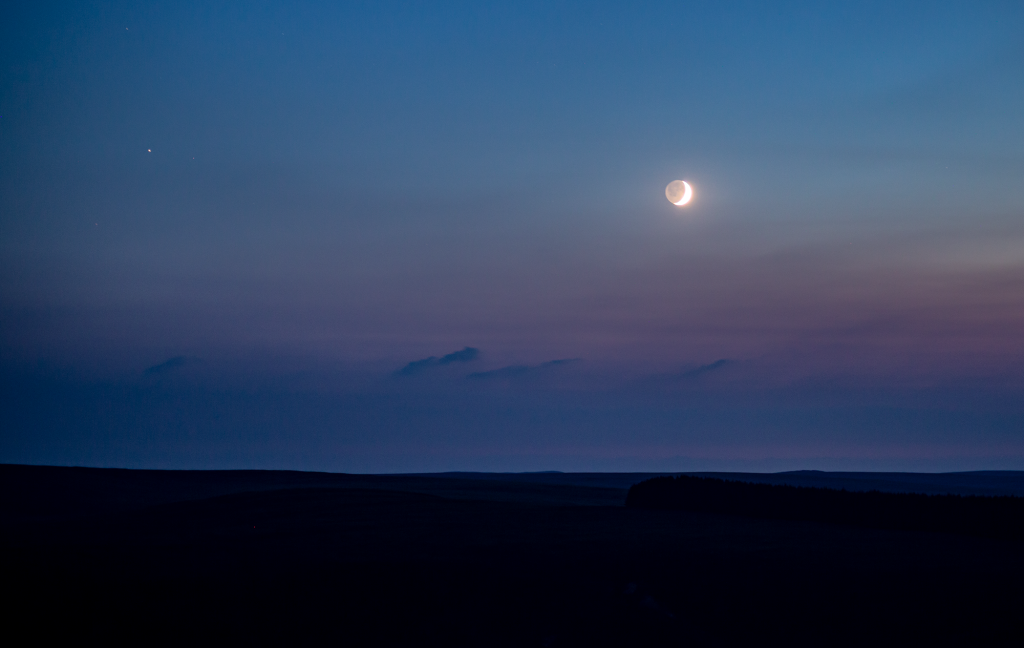Welcome to this month’s update to what’s in the night sky for December.
In the Elan Valley International Dark Sky Park, darkness falls even earlier this month – 6.10pm at the beginning of the month and 6.18pm at the end.

An all-sky view of the constellations from midnight in December from in-the-sky.org
At midnight, the constellations that are dominant in the southern night sky during December are Orion, Auriga, Taurus and Gemini.
Andromeda, Perseus and Cassiopeia are well-placed in the western sky. The summer constellations of Cygnus and Lyra set on the western horizon and the spring constellations of Cancer and Leo rise in the east.
The Full Moon occurs on 15th December. There are two New Moons this month: the first is on 1st December and the second, also known as a black moon, falls on 30th December.
The Winter Solstice falls on 21st December 2024, which is the shortest day of 7 hours, 39 minutes and the longest night of 12 hours and 5 minutes. Plenty of time for stargazing!
Credit: Sorcha Lewis


Geminids Meteor Shower
The Geminids Meteor Shower falls between 4th and 20th December, and peaks during the late night of 14th December and the early morning of 15th December.
Known to produce around 150 meteors during the peak, the meteors are fast, bright and colourful, lighting the sky up with red, green, white, yellow and blue shooting stars. Radiating from the constellation of Gemini, the shower is thought to originate from debris left by asteroid 3200 Phaethon. Unfortunately, the Full Moon will hamper seeing the meteor shower in all its glory so it is worth looking up in the days before and after the peak.
Image: NASA/JPL


The Moon and Venus
On 4th December, the Moon passes close to Venus on the low south-western horizon.
The Moon will be 12% illuminated so look out for the lovely Earthshine, where the sun’s light reflects off the surface of the Earth, illuminating the the darker part of the Moon. This occurs for a short while after sunset.
Credit: Sam Price


On the night of 14th December, the Moon passes close to Jupiter at a distance of 5°26′. This is a little over the width of three fingers held together and held at arm’s length.
On the night of 18th December, the Moon will pass close to Mars. The best time to see this is in the morning before sunrise.

The Moon will pass in front of (occult) Mars at around 9.30am but unfortunately daylight will make it difficult to see this.
For those who have small telescopes, you may be able to watch this if you know where you are looking, especially as Mars is reaching opposition, appearing at its largest and brightest (16th January 2025), which means that chances of seeing this occultation are good.
Mars emerges from the south-eastern limb of the Moon at 10:16am but by this time, both objects are very low on the horizon.
Credit: Stellarium
Orion Nebula (M42)
RA 5h 35m 17s | Dec -5° 23′ 28″
The Orion Nebula is always worth a mention this time of year as it’s simply the most beautiful nebula to study, whether you have binoculars or a telescope.
Even with the unaided eye, this nebula appears as a gleaming, bloated star, like a jewel in the sword sheath that hangs from the belt of the Constellation of Orion.
Credit: NASA ESA M. Robberto Space Telescope Science Institute ESA and the Hubble Space Telescope Orion Treasury Project Team


It is positioned well in the south-eastern / southern sky around 10pm during the month of December. The constellation is also easy to find as it is one of the brightest and most recognisable.
The easiest way to spot this constellation is to look out for three close-knit and equally-spaced stars that represent Orion’s belt.
Just below the belt hangs three, tiny stars that dangle vertically like a sword. Look for two bright stars that are either side of the sword, representing Orion’s feet and three above the belt, which comprises the shoulders and head. It should resemble an angular hourglass.
Credit: Sam Price


Through 10×50 binoculars, the Orion Nebula appears to look like the side profile of a tiny open flower, with a bright core and a slight, fuzzy outline. The nebula resolves wonderfully through telescopes of six inches of aperture and above. Through larger telescopes, nebulaic filaments can be seen and with young eyes, it even takes on slight colour.
Credit: Michael Vlasov from Deepskywatch.com
37 Cluster (NGC 2169)
RA: 06h 08m 24.3s | Dec: +13° 57′ 53″
This is a fun object to discover. Situated 3600 light years from Earth, this open cluster is located in the constellation of Orion and is a challenge to find. Look for the red supergiant Betelgeuse and in dark skies, you will see Orion’s raised arm.


Use your finder scope to locate the two stars at the ‘elbow joint’ and move it downwards slightly until you see a small, tight cluster of stars.
Look through your eyepiece; these stars should resemble the number 37, or depending on the telescope, XY, or LE or even a mirrored version of the number 37.
Credit: ScottRak – Own work CC BY-SA 3.0


Christmas tree cluster (NGC 2264)
RA: 06h 42m 20s | DEC: +09° 52’ 13”
This open cluster, full of young stars, lies 2350 light years away from us and is situated in the constellation of Monoceros.
Look for the red star Betelgeuse which comprises the right-hand shoulder of the constellation of Orion. Look for the left-hand star that is the foot of the constellation of Gemini and the Christmas Tree Cluster lies at a small distance from that star. Use your telescope’s finder scope to sight a small, tight cluster of stars and then look through your eyepiece to view it in magnified detail.
The stars can be easily seen but the Cone Nebula may be a bit of a challenge – mainly because it is tiny! Use your averted vision to see whether you can spot the cone.
You can see from the image that this open cluster resembles lights on a Christmas tree. At the top of the tree, lies the Cone Nebula at a distance of 2700 light years. It just so happens that both these objects appear to form this festive shape from our viewpoint in the Milky Way Galaxy.
Credit: ESA


NGC2264 is an emission nebula where the stars formed, but can only be captured with cameras.
In December 2023, NASA created an animation where a photograph of the young stars emitting X-rays was overlaid on the emission nebulae. You can see this by tapping the image.
You can see two out of three of these components visually using telescopes of eight inches and larger – as long as you are away from light pollution.
Credit: NASA



